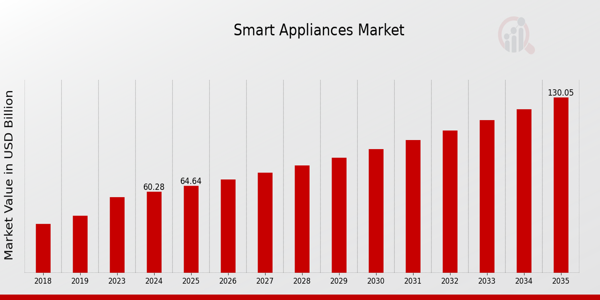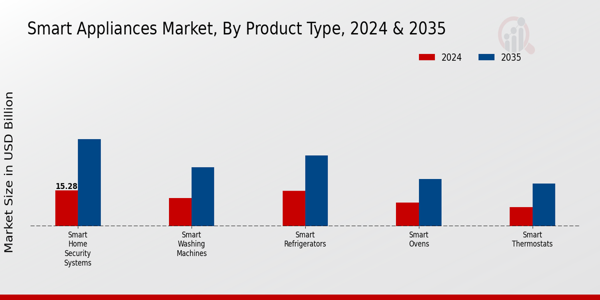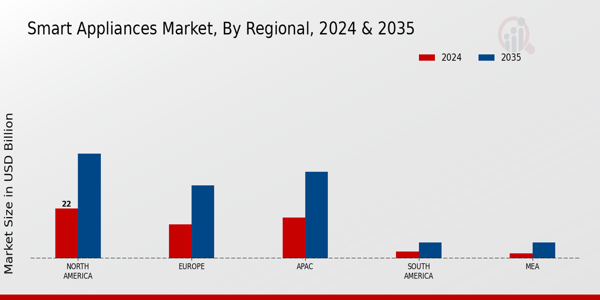Global Smart Appliances Market Research Report: By Product Type (Smart Refrigerators, Smart Ovens, Smart Washing Machines, Smart Thermostats, Smart Home Security Systems), By Connectivity (Wi-Fi, Bluetooth, Zigbee, Z-Wave, Ethernet), By End User (Residential, Commercial, Industrial), By Distribution Channel (Online Retail, Offline Retail, Third-Party Distributors) and By Regional (North America, Europe, South America, Asia Pacific, Middle East and Africa) - Forecast to 2035.
Smart Appliances Market Overview:
As per MRFR analysis, the Smart Appliances Market Size was estimated at 56.21 (USD Billion) in 2023. The Smart Appliances Market Industry is expected to grow from 60.28(USD Billion) in 2024 to 130 (USD Billion) by 2035. The Smart Appliances Market CAGR (growth rate) is expected to be around 7.24% during the forecast period (2025 - 2035).
Key Smart Appliances Market Trends Highlighted
The Global Smart Appliances Market is witnessing significant market trends driven by increasing consumer demand for convenience and efficiency in daily tasks. One key market driver is the growing adoption of the Internet of Things (IoT), which enables appliances to communicate with each other and with users through smartphone applications. This connectivity enhances convenience, allowing consumers to control their appliances remotely, which aligns with the modern lifestyle that prioritizes time savings and ease of use. Additionally, the push towards energy efficiency and sustainability is influencing the market, as smart appliances often come equipped with features that optimize energy consumption, contributing to lower utility bills and a reduced environmental footprint.Opportunities to be captured in this market include the expansion of smart home ecosystems, as consumers increasingly seek integrated solutions that can coordinate various smart devices from different manufacturers. The rise in urbanization and evolving consumer preferences towards smart living spaces further opens avenues for manufacturers to innovate and create new product offerings. The trend of integrating artificial intelligence into smart appliances is also gaining traction, enabling them to learn user habits and preferences to enhance the user experience. In recent times, the market has seen an uptick in connected kitchen appliances, such as smart ovens and refrigerators, that offer recipe suggestions or inventory management features.The availability of voice-activated controls and compatibility with major home assistants is also becoming a standard feature. According to global trends, regions are focusing on enhancing their infrastructure to support smart technology adoption, creating an environment conducive to growth in the smart appliances sector.

Source: Primary Research, Secondary Research, MRFR Database and Analyst Review
Smart Appliances Market Drivers
Increasing Consumer Demand for Energy Efficiency
Consumer demand for energy-efficient products is rising significantly, according to the global smart appliances market. Energy Star appliances consume 10 to 50 percent less energy than regular models, according to the U.S. Department of Energy. Customers are becoming more aware of their energy usage, which is reflected in this measure. Customers are searching for smart appliances that offer real-time energy monitoring and automation features so they can optimize consumption patterns as energy costs change and environmental concerns increase. By incorporating smart technologies that improve energy efficiency into their product lines, companies such as Samsung and LG Electronics are spearheading this movement. The global smart appliance market is anticipated to grow as a result of governments throughout the world promoting the use of energy-efficient appliances.
Advancements in the Internet of Things Technology
The proliferation of Internet of Things (IoT) technology is a key driver in the Global Smart Appliances Market Industry. As of 2023, it is estimated that there are over 25 billion connected IoT devices globally, according to the International Data Corporation. This burgeoning number facilitates seamless integration between appliances and personal devices, enabling consumers to control their appliances remotely through smartphones or voice-activated assistants.Companies such as Amazon are also enhancing user convenience through devices like the Amazon Echo, which supports smart home ecosystem integrations. The accessibility and affordability of IoT technology are expected to empower consumers, driving further growth in the Global Smart Appliances Market.
Shifts in Consumer Lifestyle and Home Automation Trends
Changes in consumer lifestyle, particularly in urban areas, have been influential in shaping the Global Smart Appliances Market Industry. A report by the United Nations states that by 2050, nearly 68% of the world's population will live in urban areas, driving the need for efficient household management solutions. As people adopt busier lifestyles, there is a growing demand for smart appliances that facilitate home automation and enhance convenience.For example, smart ovens and refrigerators can now be programmed for specific cooking needs or food inventory management, appealing strongly to busy professionals. Major brands like Whirlpool and Bosch are expanding their portfolios to include user-friendly smart appliances that cater to the modern consumer's needs, thus fuelling market growth.
Smart Appliances Market Segment Insights:
Smart Appliances Market Product Type Insights
The Global Smart Appliances Market segment, specifically focusing on Product Type, reveals a dynamic landscape with various key components driving the market's growth. In 2024, the market is valued at 15.0 USD Billion, Smart Ovens at 10.0 USD Billion, Smart Washing Machines at 12.0 USD Billion, Smart Thermostats at 8.0 USD Billion, and Smart Home Security Systems at 15.28 USD Billion. Notably, the Smart Refrigerators segment holds a substantial share, representing a significant portion of the market due to their ability to enhance food preservation and energy efficiency while being integrated with smart technology. This appliance is projected to reach a valuation of 30.0 USD Billion by 2035, showcasing the growing consumer preference for features like inventory management and remote monitoring. Smart Ovens also show considerable promise, with anticipated growth to 20.0 USD Billion by 2035, driven by the convenience of automated cooking and recipe assistance. The Smart Washing Machines segment, valued at 12.0 USD Billion in 2024 and projected to rise to 25.0 USD Billion by 2035, highlights the increasing demand for smart laundry solutions that offer efficiency and connectivity, appealing to environmentally conscious consumers. In addition, Smart Thermostats are expected to expand from 8.0 USD Billion in 2024 to 18.0 USD Billion by 2035, reflecting the growing importance of energy management and temperature control in households as part of smart energy practices. These devices contribute significantly to energy saving, making them a preferred choice in the Global Smart Appliances Market. Lastly, the Smart Home Security Systems segment, valued at 15.28 USD Billion in 2024 and projected to grow to 37.0 USD Billion by 2035, emphasizes the increasing consumer concern for safety and security solutions in homes. The adoption of these systems is driven by technological advancements and a heightened awareness of home security risks. Overall, the diverse Product Type offerings within the Global Smart Appliances Market showcase trends towards convenience, energy efficiency, and enhanced security, providing a broad spectrum of opportunities for both consumers and manufacturers alike.

Source: Primary Research, Secondary Research, MRFR Database and Analyst Review
Smart Appliances Market Connectivity Insights
The Connectivity segment of the Global Smart Appliances Market plays a crucial role in enhancing the usability and functionality of smart devices. As the overall market is valued at 60.28 USD Billion in 2024, the importance of connectivity protocols is emphasized due to their essential function in seamless communication among devices. Connectivity technologies such as Wi-Fi, Bluetooth, Zigbee, Z-Wave, and Ethernet serve as the backbone for smart appliances, enabling features like remote control, automation, and personalized user experiences.Wi-Fi, for instance, is widely adopted due to its ability to support high-speed internet connectivity, making it vital for everyday appliances such as smart refrigerators and ovens. Bluetooth facilitates short-range wireless communication, making it ideal for personal devices, while Zigbee and Z-Wave, both low-power protocols, are significant for home automation, allowing devices to operate efficiently in low-energy environments. Ethernet provides a stable and high-speed connection, often used in appliances requiring great reliability. The Global Smart Appliances Market statistics indicate a growing demand for these connectivity solutions as consumers increasingly seek integrated smart home ecosystems, driving market growth and innovations within this segment.
Smart Appliances Market End User Insights
The Global Smart Appliances Market is seeing significant growth within its End User segment, with a market value of 60.28 billion USD in 2024. This market primarily serves three distinct sectors: Residential, Commercial, and Industrial. The Residential sector plays a crucial role as consumers increasingly seek convenience and energy efficiency, making home automation systems desirable. The Commercial sector is also important, as businesses leverage smart appliances to optimize operations and decrease operational costs. Additionally, the Industrial segment is gaining traction as organizations adopt smart technologies for enhanced productivity and resource management.Overall, the Global Smart Appliances Market revenue demonstrates strong potential, driven by technological advancements, rising consumer awareness, and a growing need for energy management solutions. However, the market faces challenges such as high initial costs and the complexity of integration into existing systems. Nonetheless, the opportunities for growth are substantial, particularly as smart appliance technologies evolve, offering enhanced features that appeal to diverse end users across the Global landscape. The Global Smart Appliances Market data showcases a compelling trend toward increased automation and connectivity, aligning with the broader shift toward smart home and business environments.
Smart Appliances Market Distribution Channel Insights
The Distribution Channel segment of the Global Smart Appliances Market plays a pivotal role in the overall accessibility and growth of these innovative products. In 2024, the complete market is valued at 60.28 USD Billion, showcasing significant consumer interest in smart appliances. The online retail segment has emerged as a dominant force, driven by the growing adoption of e-commerce and the increasing preference for convenient shopping experiences. Meanwhile, offline retail remains essential, providing consumers the opportunity to experience products firsthand, building trust, and enhancing customer satisfaction.Third-party distributors also contribute importantly to market reach, facilitating the availability of smart appliances across diverse regions. As connectivity and smart home adoption grow, the need for effective distribution channels becomes increasingly critical in ensuring that consumers can access the latest technology seamlessly. With global trends favoring sustainability and energy efficiency, the Global Smart Appliances Market revenue continues to evolve, underlining the importance of strategic distribution approaches to align with changing consumer preferences.
Smart Appliances Market Regional Insights
The Global Smart Appliances Market revenue is projected to see significant growth across various regions, with the North America segment holding a majority share. Valued at 22.0 USD Billion in 2024 and expected to reach 46.0 USD Billion in 2035, North America's market is driven by technological advancements and a strong consumer preference for automation. Following closely, Europe shows a robust trajectory, with a valuation of 15.0 USD Billion in 2024, growing to 32.0 USD Billion by 2035, as sustainability trends push consumers towards energy-efficient smart solutions.The Asia-Pacific (APAC) region, valued at 18.0 USD Billion in 2024 and reaching 38.0 USD Billion in 2035, noteworthy for its rapid urbanization and increasing disposable income, presents ample opportunities for growth in smart appliances adoption. Meanwhile, South America, despite a lower starting value of 3.0 USD Billion in 2024, is anticipated to grow to 7.0 USD Billion by 2035, driven by an emerging middle class. Lastly, the Middle East and Africa (MEA) region is valued at 2.28 USD Billion in 2024 and is projected to reach 7.0 USD Billion in 2035, with increasing investments in technology infrastructure.Overall, the Global Smart Appliances Market data reflects a regional landscape rich with growth potential influenced by diverse trends.

Source: Primary Research, Secondary Research, MRFR Database and Analyst Review
Smart Appliances Market Key Players and Competitive Insights:
The Global Smart Appliances Market is characterized by a dynamic and rapidly evolving landscape, reflecting the complex interplay of technology advancements, consumer preferences, and environmental considerations. Companies in this market are increasingly focusing on integrating the Internet of Things (IoT) into their products, allowing consumers to manage appliances remotely and enhance their convenience and efficiency. As competition intensifies, players are innovating to differentiate their offerings while also addressing sustainability concerns that have become central to buying decisions. The market is seeing a surge of new entrants and traditional appliance manufacturers capitalizing on advancements in artificial intelligence and smart technologies to deliver novel solutions that exceed customer expectations. Whirlpool Corporation has established itself as a formidable player in the Global Smart Appliances Market through its robust portfolio of innovative products designed to meet evolving consumer needs. The company emphasizes its commitment to quality and reliability, which have solidified its reputation over the years. Whirlpool Corporation's strengths lie in its extensive research and development capabilities, enabling the introduction of cutting-edge technologies that optimize energy efficiency and convenience. The brand maintains a significant market presence globally, supported by a vast distribution network that ensures accessibility to its wide range of smart appliances. Furthermore, Whirlpool Corporation has been proactive in strategic partnerships and collaborations, allowing it to stay ahead of technological advancements and consumer trends, strengthening its competitive position within the market.Panasonic has made notable inroads into the Global Smart Appliances Market, leveraging its long-standing expertise in electronics and innovation to offer a varied range of smart appliances. The company's product portfolio includes smart refrigerators, washing machines, and kitchen appliances that incorporate features aimed at enhancing user experience and maximizing efficiency. Panasonic's strength lies in its reputation for quality and sustainability, reflected in its commitment to eco-friendly technologies and energy-efficient solutions. The company has been involved in strategic mergers and acquisitions, positioning itself to strengthen its market reach and innovate its offerings further. Panasonic's global market presence is underpinned by a strong brand equity and a focus on integrating advanced technology, such as AI and IoT, into its products, thereby enhancing consumer lifestyles and maintaining competitive advantage in the global arena.
Key Companies in the Smart Appliances Market Include:
Whirlpool Corporation
Panasonic
GE Appliances
Philips
Apple
Electrolux
Sony
Haier
Samsung Electronics
Siemens
TCL Technology
Honeywell
Miele
Bosch
LG Electronics
Smart Appliances Market Industry Developments
The Global Smart Appliances Market has recently seen notable developments, particularly with companies like Whirlpool Corporation, Panasonic, and Samsung Electronics. In November 2023, Whirlpool Corporation announced the expansion of its smart appliance range, leveraging advanced connectivity features, which is expected to enhance user experience and energy efficiency. Panasonic has introduced AI-driven innovations across its smart kitchen appliances, aiming to increase versatility and convenience for consumers. Meanwhile, Samsung Electronics revealed its latest smart refrigerator model equipped with a health management system, allowing users to track food freshness via a mobile app. In terms of mergers and acquisitions, there were no recent announcements reported in the last few months regarding the specified companies. However, the overall market growth is evident, with market valuations increasing significantly due to rising consumer demand for energy-efficient appliances. Major developments over the past two to three years include Electrolux's acquisition of a smart home startup in March 2022 to bolster its technological capabilities and LG Electronics investing in Research and Development for smart laundry technologies in September 2021. The ongoing technological advancements are shaping the industry's future and driving competition among key players in the Global Smart Appliances Market.
Smart Appliances Market Segmentation Insights
Smart Appliances Market Product Type Outlook
Smart Refrigerators
Smart Ovens
Smart Washing Machines
Smart Thermostats
Smart Home Security Systems
Smart Appliances Market Connectivity Outlook
Wi-Fi
Bluetooth
Zigbee
Z-Wave
Ethernet
Smart Appliances Market End User Outlook
Residential
Commercial
Industrial
Smart Appliances Market Distribution Channel Outlook
Online Retail
Offline Retail
Third-Party Distributors
Smart Appliances Market Regional Outlook
North America
Europe
South America
Asia Pacific
Middle East and Africa
Report Scope:
| Report Attribute/Metric Source: |
Details |
| MARKET SIZE 2023 |
56.21(USD Billion) |
| MARKET SIZE 2024 |
60.28(USD Billion) |
| MARKET SIZE 2035 |
130.0(USD Billion) |
| COMPOUND ANNUAL GROWTH RATE (CAGR) |
7.24% (2025 - 2035) |
| REPORT COVERAGE |
Revenue Forecast, Competitive Landscape, Growth Factors, and Trends |
| BASE YEAR |
2024 |
| MARKET FORECAST PERIOD |
2025 - 2035 |
| HISTORICAL DATA |
2019 - 2024 |
| MARKET FORECAST UNITS |
USD Billion |
| KEY COMPANIES PROFILED |
Whirlpool Corporation, Panasonic, GE Appliances, Philips, Apple, Electrolux, Sony, Haier, Samsung Electronics, Siemens, TCL Technology, Honeywell, Miele, Bosch, LG Electronics |
| SEGMENTS COVERED |
Product Type, Connectivity, End User, Distribution Channel, Regional |
| KEY MARKET OPPORTUNITIES |
Smart home integration growth, Rising demand for energy efficiency, Increased consumer awareness and adoption, Expansion in developing markets, Advancements in IoT technology |
| KEY MARKET DYNAMICS |
Technological advancements, Rising consumer demand, Energy efficiency, Smart home integration, Increased disposable income |
| COUNTRIES COVERED |
North America, Europe, APAC, South America, MEA |
Smart Appliances Market Highlights:


















